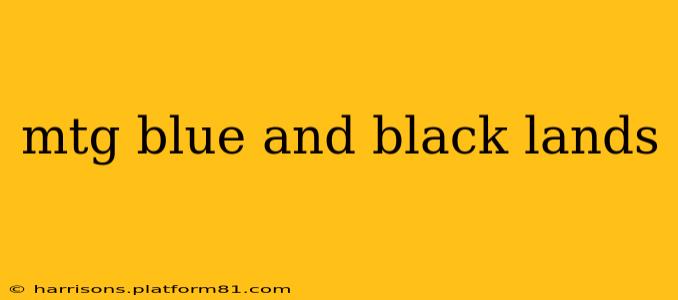Blue and black are powerful colors in Magic: The Gathering, often forming the backbone of control and combo decks. A strong mana base is crucial for consistent gameplay, and understanding the best lands for a blue-black deck is key to success. This guide explores the various options, catering to different strategies and budget levels. We'll delve into the nuances of each land type, examining their strengths and weaknesses to help you build the perfect mana base for your next blue-black deck.
What Makes a Good Blue-Black Land?
Before diving into specific cards, let's establish the key characteristics of an ideal blue-black land. Ideally, your lands should:
- Produce blue and/or black mana: This seems obvious, but some lands offer additional benefits at the cost of dual-colored mana production. Weigh these trade-offs carefully based on your deck's strategy.
- Enter the battlefield untapped: Untapped lands allow you to cast spells on your turn, crucial for controlling the pace of the game.
- Be resilient to disruption: Some lands can be destroyed or otherwise negatively affected by opponent's strategies. Prioritize lands that are hard to remove.
- Provide additional value: Some lands offer additional benefits beyond mana production, such as card draw, life gain, or other effects. These are often premium cards that are worth considering for more competitive decks.
Common Blue and Black Lands in MTG
Here are some of the most common and effective blue and black lands you'll find in various MTG formats:
Dual Lands:
These lands produce both blue and black mana, usually untapped. They are highly sought after and often expensive, making them more suitable for competitive decks with a higher budget. Examples include:
- Underground Sea: A classic powerhouse, providing consistent dual color mana.
- Polluted Delta: A fetch land that can search your deck for a basic land, ensuring you have the colors you need. (Requires careful deck construction)
- Watery Grave: Another powerful dual land, offering consistent mana production.
Fetch Lands:
Fetch lands, like Polluted Delta, are powerful tools for mana fixing. They allow you to search your deck for a basic land, but they enter tapped. This is a worthwhile trade-off in many decks, particularly those that run a significant number of shocklands or other tapped lands.
Shock Lands:
These lands enter the battlefield tapped, but produce either blue or black mana. The upside is that they produce a significant amount of mana at the cost of occasionally being tapped on your turn. Examples include:
- Drowned Catacomb: Enters tapped, but produces either black or blue mana. A solid budget choice for blue-black decks.
- Godless Shrine: While primarily black-white, it can be used in decks that can use a white splash.
Check Lands:
Check lands enter the battlefield tapped unless you control another land of a specific type (usually a basic land). They can be a good budget alternative to dual lands, but their mana production can be inconsistent early in the game.
Battle Lands:
Battle lands enter the battlefield tapped, but produce either blue or black mana. They can also produce additional colors. Similar to Shock lands, these are useful in decks that run a significant number of basic lands.
H2: What are some budget-friendly options for blue-black lands?
Budget-friendly options exist, but they often sacrifice the consistency of dual lands. Consider these:
- Basic lands: Islands and Swamps are free and always available, but they lack the flexibility of dual lands. They form the backbone of any budget-friendly mana base.
- Check lands: While entering tapped, check lands eventually provide untapped mana if you have basic lands in play.
H2: How many lands should I include in my blue-black deck?
The optimal number of lands depends on your deck's strategy and the mana costs of your spells. Generally, a good starting point is around 24-26 lands for a 60-card deck. Adjust this number based on your specific deck's needs. If you have many high-cost spells, you'll likely want more lands. Conversely, if your deck focuses on cheaper spells, you can get away with fewer lands.
H2: Are there lands that provide additional effects in blue-black?
Yes, some lands offer additional value beyond mana production. These are often powerful, but expensive, cards. Examples include lands that can produce additional mana, draw cards, or provide other strategic advantages.
H2: What are some advanced strategies for mana base building in blue-black?
Advanced strategies involve carefully considering the synergy between your lands and your deck's overall strategy. This might involve using fetch lands to search for specific basic lands, leveraging the abilities of shock lands or other tapped lands to maximize your mana production, or utilizing lands that provide additional effects to further enhance your game plan.
This guide offers a foundational understanding of blue-black lands in MTG. Remember to consider your budget, deck strategy, and the specific cards you're using when building your mana base. Experimentation is key to finding the optimal configuration for your deck.
